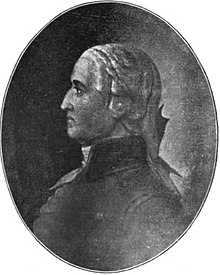John Augustine Washington
| John Augustine Washington | |
|---|---|
 | |
| Born | 1736 |
| Died | 1787 |
| Spouse(s) | Hannah Bushrod |
| Children | Bushrod Washington, Corbin Washington, Jane (Jenny) Washington |
| Parent(s) | |
| Family | Washington family |
John Augustine Washington (1736–1787)[1] was a member of the fifth Virginia Convention and a founding member of the Mississippi Land Company.[2] During the American Revolution he was a member of Westmoreland County's Committee of Safety and the Chairman of the County Committee for Relief of Boston.[3][4]
Early and family life[]
The brother of President George Washington and the third son of Mary Ball and Augustine Washington was born in what was then Prince William County, Virginia (and is now Fairfax County, Virginia).[5]
John Washington married (1735-1801) in 1756, when he was not yet 20 years old. They had two daughters by 1760, Mary and Jenny, probably both born at Mount Vernon as discussed below.[6] They then had two sons, both probably born at Bushfield in Westmoreland County: the eldest was named for his maternal grandfather and ultimately became United States Supreme Court Justice Bushrod Washington, and his brother Corbin was named after the family of his maternal grandmother.
Career[]
By his father's will, John Washington inherited 700 acres at the "head of Maddox" (Mattox Creek is a navigable tributary of the Potomac River) in Westmoreland County, which had been the first land the Washington family had owned in Virginia.[7] This estate was about 20 miles from Bushfield, the plantation operated by his wife's family As a young man, John Washington managed Mount Vernon for his brother George, who was active in surveying western lands, and he brought his wife Hannah there in 1756, although both moved to Bushfield in 1759, in part because her father had fallen ill (and would die the following year), and in part because George Washington married Martha and chose to settle at Mount Vernon. John Washington and Richard Corbin became the executors of John Bushrod's will, which left land, furniture and 35 slaves to Hannah, and three slaves each to her daughters Mary and Jenny Washington. John Washington also held an estate sale at Mount Vernon on September 21, 1761.[8]
In February, 1766, at Leedstown in Westmoreland County, John Washington became one of the signatories of the Westmoreland Resolves., which created an association to oppose the Stamp Act passed by Parliament the previous year[9] When the port of Boston was closed because of protests in the Massachusetts colony, John Washington became chairman of the relief committee in Westmoreland County and forwarded 1092 bushels of grain. His brother George visited Bushfield many times, and John also visited Mt. Vernon.[10]
Death and legacy[]

John Augustine Washington died unexpectedly at Bushfield on the 8th or 9 January 1787, and a messenger rode to Mount Vernon with the news.[11] He and his widow Hannah are believed buried on the grounds of Bushfield, but no stone remains to mark their graves in the family plot. A stone in his honor was erected by the Daughters of the American Revolution in the churchyard of Pohick Church in 1986.[12]
References[]
- ^ (1) "Hannah Bushrod". Ancestry. 2016. Archived from the original on 2016-01-22. Retrieved 2016-01-22.
(2) "George Washington's Family Chart". Mount Vernon Ladies' Association. Archived from the original on 2011-07-17. Retrieved 2016-01-22. - ^ Massachusetts, Colonial Society of (1906). "Transactions 1902 – 1904". Publications of the Colonial Society of Massachusetts. Cambridge USA: University Press: John Wilson and Son. VIII. Retrieved 2008-03-21.
- ^ "George Washington's Family Chart". Mount Vernon Ladies' Association. Archived from the original on 2011-07-17. Retrieved 2015-01-22.
- ^ Coleman, Charles Washington (April 1897). "The County Committees of 1774-'75 in Virginia: II". William and Mary College Quarterly Historical Magazine. 5 (4): 245–255. doi:10.2307/1914928. JSTOR 1914928.
- ^ John W, Wayland (1944). The Washingtons and their Homes. Berryville, Va: Virginia Book Company.
- ^ Wayland p. 109
- ^ Wayland p. 109
- ^ Wayland pp. 111-113
- ^ Wayland pp. 113-117
- ^ Wayland pp. 117-121
- ^ Wayland p. 121
- ^ "CJW History: 1973-1985". Retrieved 23 February 2016.
External links[]
- 1736 births
- Washington family
- 1787 deaths
- Virginia colonial people
- American people of English descent
- British North American Anglicans
- People from Westmoreland County, Virginia
- American planters
- American politics biographical stubs

